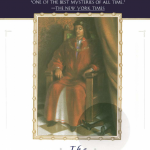This post was first posted in August of 2004.
When I first ran into The Da Vinci Code I knew it was nonsense; as history buff, I already had enough general historical knowledge under my belt that it smelled really bad. Nevertheless, it prompted me to go out and see what I could find on the specifics, and this book is the first fruits of that.
The History of the Church is the earliest history we have of the Christian faith in its first few centuries. Eusebius was born around 260 AD, and wrote most of the book between 315 and 325 AD. It begins with Jesus and the apostles, and traces the apostolic succession down to the early reign of Emperor Constantine. Along the way Eusebius discusses a variety of persecutions, martyrs, heresiarchs, and the like, along with a number of comments on the canon of the New Testament, and in so doing he quotes a vast number of sources at great length. Indeed, in some ways, that’s the chief value of Eusebius; he wasn’t an original thinker, but he had a large, well-stocked library and quoted from it liberally. Many of the passages he cites we know only from his quotations; where we have the source documents as well, he is shown to be fairly trustworthy.
So what did I learn from Eusebius?
First, that the canon of the New Testament, although still somewhat fluid even up to the end of Eusebius’ life, was nevertheless pretty well thrashed out. All of the books we currently have in the New Testament were well-known to Eusebius and his sources, many of which date from the first and second centuries, and were liberally quoted by them. In Eusebius’ day there was still some controversy about Revelations, Paul’s Letter to the Hebrews (Eusebius maintained that it had indeed been written by Paul, but in Hebrew, and was translated into Greek by Clement of Rome), and some of the so-called “Catholic” letters. On the other hand, the various “gnostic” gospels so beloved of certain scholars these days as holding hidden knowledge—the Gospel of Thomas, for example—were also well known to Eusebius and his predecessors, and were generally dismissed as bogus. (The discussion often involves comments on the style of the various authors; it sounds quite contemporary to my ears.) In short, the New Testament was too well known and too widely quoted in earlier times to be the work of Constantine, as Dan Brown would have it.
Second, the early Christians were dedicated to (among other things) preserving the faith as they had received it from the apostles, and as a result they had a short way with heresy.
Most of you are probably now picturing witch hunts and auto-da-fés, but nothing could be further from the truth. Christianity was never spread by violence until it became married to the power of the state by Constantine, and even after that it was spread violently much less frequently than most people would suppose. But be that as it may, in the time period of which I’m writing Christianity spread from person to person without any form of coercion—the early Christians had no power, and hence no way to coerce anyone.
The way they dealt with heresy was manifold. Heretics were shunned. Books and pamphlets were written refuting their heresies; a number of these have come down to us. If a bishop should fall into heresy a synod, or council, would be convened and the matter thrashed out; if the council found that the bishop was indeed in error, he would be stripped of his position. If heretics repented, they were received back into the fellowship—but were never again given positions of responsibility. And that was the extent of it. Some heresies and their purveyors persisted for decades, but the early Christians stood firm against them, and in the end they came to nothing.
It’s notable that heresy was usually linked to a lust for power and wealth; even allowing for exageration, Paul of Samosata sounds like a third-century Jim Bakker.
This is yet another reason why the so-called “gnostic” gospels were abandoned—the church as a whole, which at that time was a collection of city churches united in one faith but distributed over the whole of the Roman empire, judged them false and didn’t preserve them, because they didn’t accord with the faith received from the apostles.
Third, the early Christians were willing to die for their faith. It was customary for Roman citizens to make certain sacrifices during the course of the year; and in many cities, especially in Asia, the emperor or his predecessors were accorded divine honors. The early Christians refused to have anything to do with such sacrifices, which led to the initial waves of persecution. Christians were accused of a variety of evil practices (including incest and baby-eating), they were imprisoned, they were flogged, they were burned at the stake, they were given to wild beasts in the arena, they were starved, they were torn apart and thrown into the sea to feed the fishes, they were tortured in various ways, periodically, all through the first three centuries of the church.
What impressed me particularly was the way most of the martyrs died. They had taken to heart Christ’s saying from the Sermon on the Mount, “Blessed are you when people insult you, persecute you and falsely say all kinds of evil against you because of me. Rejoice and be glad, because great is your reward in heaven, for in the same way they persecuted the prophets who were before you.” Under the torture, some certainly renounced their faith; of these, some few repented later. But most seem to have gone to their deaths rejoicing that they had been thought worthy to suffer and die as witnesses to Christ. “Witness” — that’s what the word “martyr” means.
It’s not that these early Christians were so eager to die that they went looking for trouble. But if trouble came to them, they were determined to die as well as they possibly could. We’re all familiar with the image of the Christians being thrown to the lions; it was even used in a Bugs Bunny cartoon. (Yosemite Sam, the captain of the Imperial Guard, had to find a victim for Emperor Nero.) What I didn’t know is that sometimes the lions, for whatever reason, balked—so that the martyrs had to encourage them to eat. And they did.
Think about that for a moment. It seems crazy—until you remember the pearl of great price.
As a follow-on to Eusebius, I’ve found a book that has material written by four of his sources: Clement of Rome, Ignatius of Antioch, Justin Martyr, and Irenaeus of Lyons. Clement and Ignatius date from the first century; Justin Martyr and Irenaeus of Lyons from the second. (As an indication of the size of Roman empire and the rapid spread of Christianity, note that Irenaeus was the head of a sizeable church in the city of Lyons, in what’s now France.) It took me many months to work my way through Eusebius, so don’t hold your breath.
For the record, the book was Rod Bennett’s Four Witnesses: The Early Church in Her Own Words, and I loved it.











